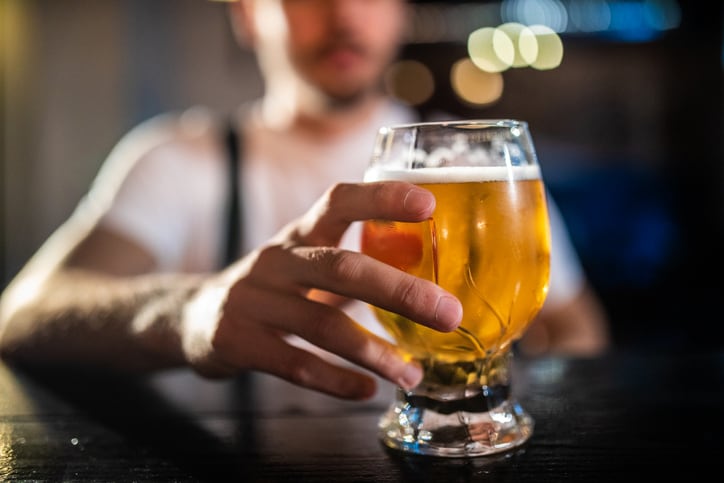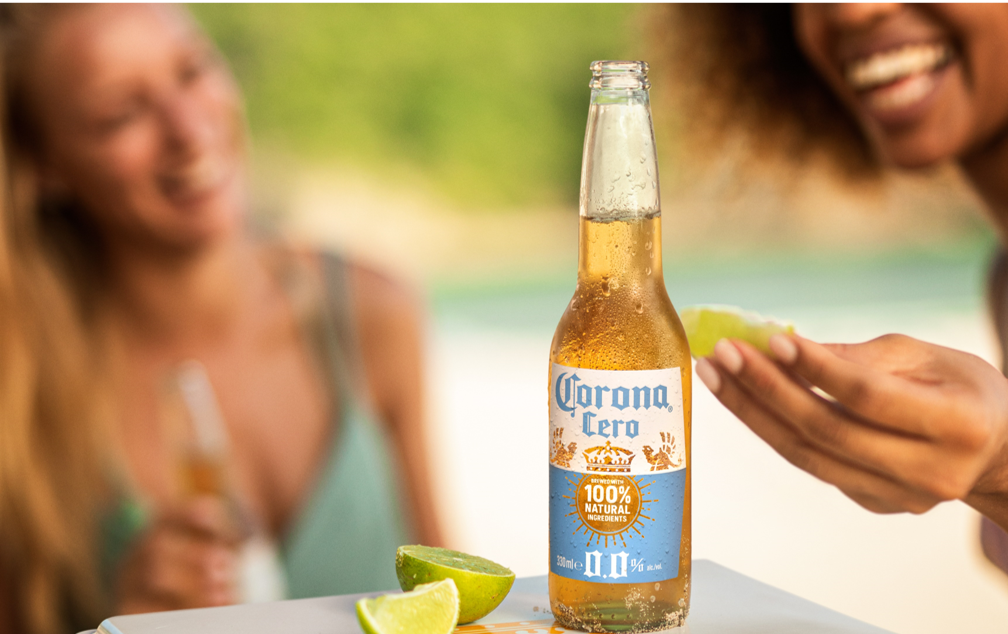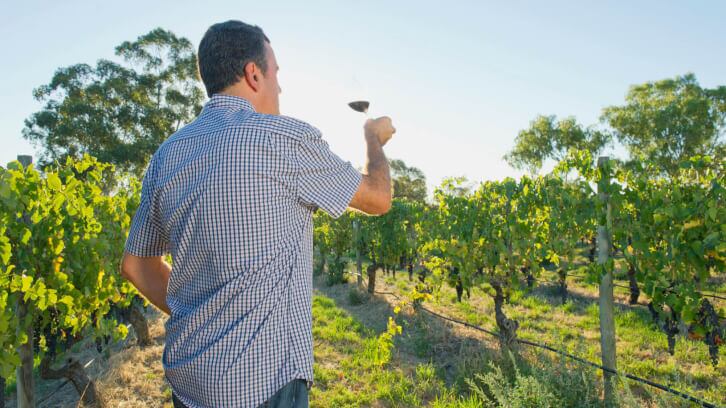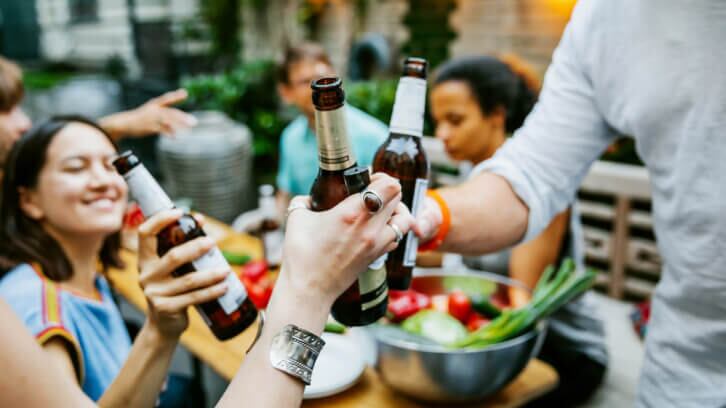The consensus among brand owners is that finding a full and satisfying flavor experience is a tough nut to crack: having all taken years of experimentation and failed recipes before finding their winning launches.
With dedication and careful research, they’re all confident they’ve found products that can meet up to consumers’ expectations. But beyond this, they see the space for flavors to evolve further as more and more brands get involved in the fast-growing category.
LOAH: 'Our idea is to bring something new, interesting and different for a range of different palates'
Launching in 2021, UK alcohol-free beer LOAH has focused on fruit flavors with a portfolio covering a Blood Orange IPA, Lager Lime and Lager Peach.
The company’s aim was not so much to replicate a classic beer but to create new products to develop the category – ‘We use the basis of beer styles, then develop them to fruits – we want to appeal to more people than just beer drinkers’, explains co-founder Hugo Tapp.
And yet despite the full fruit focus, the brand has been clear to steer away from sweet and sickly fruit flavors.
“Our beers packed full of flavor: they’re all crisp, clean and really refreshing,” said Tapp. “We achieve a decent amount of body and complexity.
“There is no sugar involved, our beers are not sweet. In fact our main aim is to avoid the worty sweetness associated with most non-alcoholic beers.
“Our idea is to bring something new, interesting, and different that attract a range of different palates.”
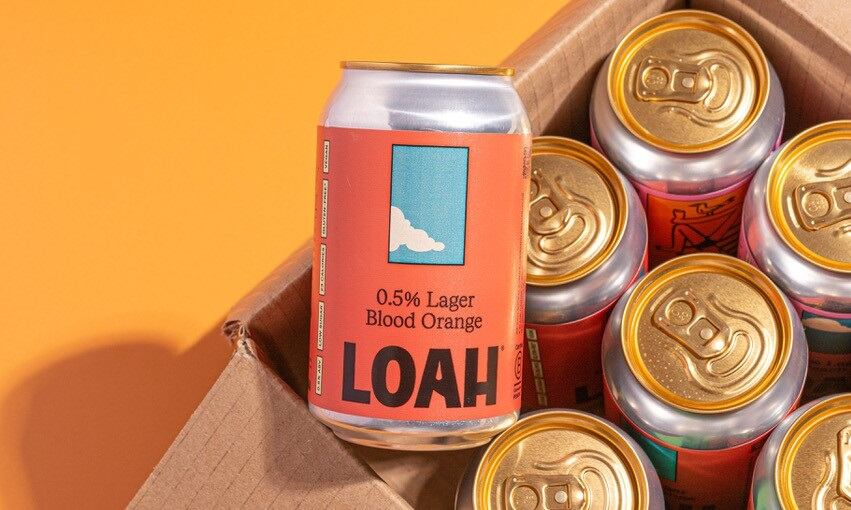
The company brews its products naturally to 0.5%: then it carefully matches hop varieties to the fruit profiles its aiming for. It then uses natural fruit extracts to balance them out and subtly bring up the flavor.
So how hard was it to come up with a good brew? “Extremely!,” says Tapp. “We brewed about 600HL before we were actually happy with any of our beers!
"From my experience it's a lot harder [than alcoholic beers] to produce good NA. Firstly you have all of the flavour, body and taste issues to get right (which is really hard without alcohol) then you have the added difficulty that you've not got alcohol as a stabiliser, so you have to do something additional in packaging to keep the beer from harm.”
HOP WTR: 'We’ve developed a proprietary digital testing process for our new flavor launches'
Blurring the categories is Southern California's HOPWTR - a non-alcoholic hop-filled sparkling water brewed with adaptogens and nootropics - which is positioned as a healthy alternative to beer.
“HOP WTR is in the hoppy water category, so it’s a sparkling water boosted with hops, so while you do get that hoppy, piney flavor that you look for when drinking a good beer, we did not intend to make the product taste exactly the same,” explained Jordan Bass, co-founder and CEO of the brand, which launched in 2020 and is now available in more than 5,000 retail location across the US including Target, Trader Joe’s, Wegmans, Whole Foods, CVS and more.
“We wanted to create a beverage that was reminiscent of your favorite IPA, which is why each flavor contains a special blend of brewer-approved hops, but we also wanted to have that functional beverage aspect, so each can of HOP WTR also provides your daily dose of Vitamin C, as well as ashwagandha and L-Theanine to help you unwind and de-stress.”
As the name might suggest, at the core of its product is the flavor from hops.
“We use a special blend of brewer-approved hops including Citra, Amarillo, Mosaic and Azacca to deliver a bold, piney hop flavor,” explained Bass.
"On select SKUs, we’ll then incorporate Non-GMO Project Verified natural fruit flavors specifically chosen to pair well with hops, like lime, blood orange and ruby red grapefruit.
"We have developed a proprietary process to bring all these ingredients together, carbonate them exactly to our specifications, can it up and then ship it out.”
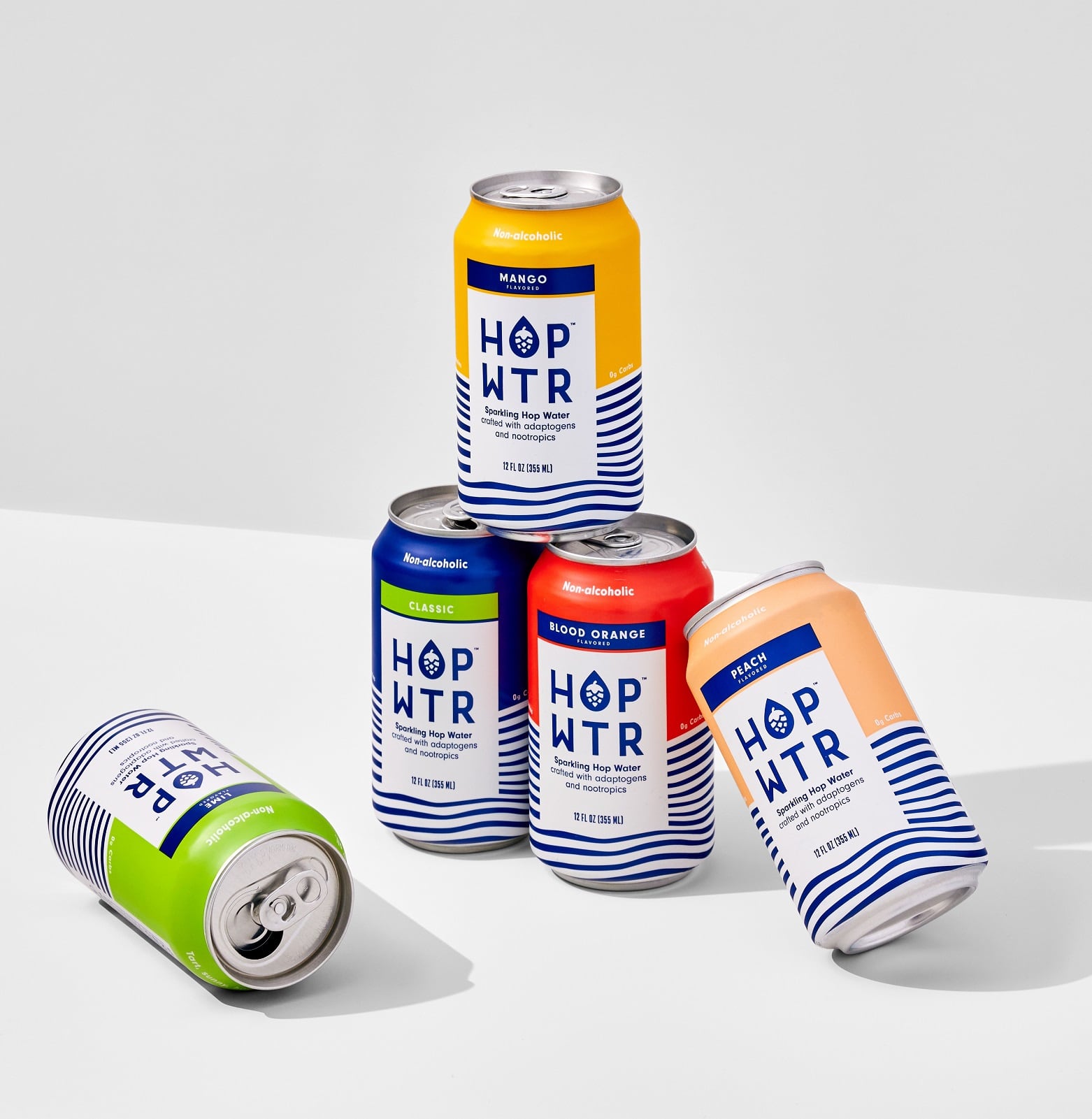
With the launch of Ruby Red Grapefruit this summer, the brand now has a roster of six flavors in addition to its classic product: Mango, Blood Orange, Lime, Ginger Limeade, Peach and Ruby Red Grapefruit.
It’s designed its line-up to have a ‘flavor for every palate’ – whether that’s classic, citrusy, tropical or juicy.
“All of our seven core flavors are refreshing, bold, and hoppy; our liquid brings a nice fruit-forward flavor alongside a hit of hops," said Bass.
"We chose flavors that resonate with our consumer, who is looking for a beverage that’s hydrating, refreshing, and gives them that hoppy taste they crave.
“Our most recent offering, Ruby Red Grapefruit has been wildly successful, which we anticipated since grapefruit is one of the most popular flavors in the sparkling water and craft beer categories. Another best-selling flavor is Blood Orange - the citrusy, bright profile complements the hops really well and our consumers reach for this SKU year-round. We also have more traditional flavors like Classic and Lime that really put the flavor of the hops at the forefront and are perfect for the consumer looking for something a bit more traditional and reminiscent of an IPA.”
As the launch of Ruby Red Grapefruit illustrates, the company’s strategy has been to look at what’s trending in the market place and then assess how that can pair with a hop blend.
“We’ve developed a proprietary digital testing process that we incorporate into our research and development for any new flavor launch. This process has been integral in helping us de-risk new flavor launches by targeting concepts and flavors we know our consumers are interested in purchasing.”
Big Drop: 'Beer is beer - whatever its ABV'
But what about non-alcoholic beers that don't use fruit flavors and are purely focused on the flavor of - well - beer?
Rob Fink, founder of pioneering UK non-alcoholic beer brand Big Drop Brewing (which launched in 2016), says that creating a genuine beer flavor is all about the process.
"Big Drop makes beer: pure and simple," he said. "We don't think that beer should be defined by its ABV. Instead, flavour and process should really be what means a drink is a beer.
"We use exactly the same process as brewers have used for thousands of years to make beer....just with a couple of tweaks to mean the ABV is never more than 0.5% ABV."
The brewery now has a portfolio of beer ranging from citrus IPA and pale ale to a milk stout.
"Our flavour profiles for our different styles of beer are exactly the same across our range as for their alcoholic cousins. So, our lager is crisp and refreshing; our IPA is happy with a citrus twist; and our stout has roasted malt flavours with coffee notes."
The brewery has also branched out with collabs on brews such as an elderflower IPA, hibiscus saison, pumpkin spiced and hazelnut porter.
Wednesday's Domaine: 'We've focused on the sensory experience of wine'
Alcohol-free wines have not yet seem the same popularity of alcohol-free beers: because the technical challenges in creating an alcohol-free wine are far greater with alcohol playing a significant role in supporting the flavors, aromas and textures that make each wine distinctive.
Wednesday’s Domaine – an alcohol-free wine which launched in London in July last year – recognizes that alcohol-free versions need to have the same complexity and interest as alcoholic wines in order to be successful.
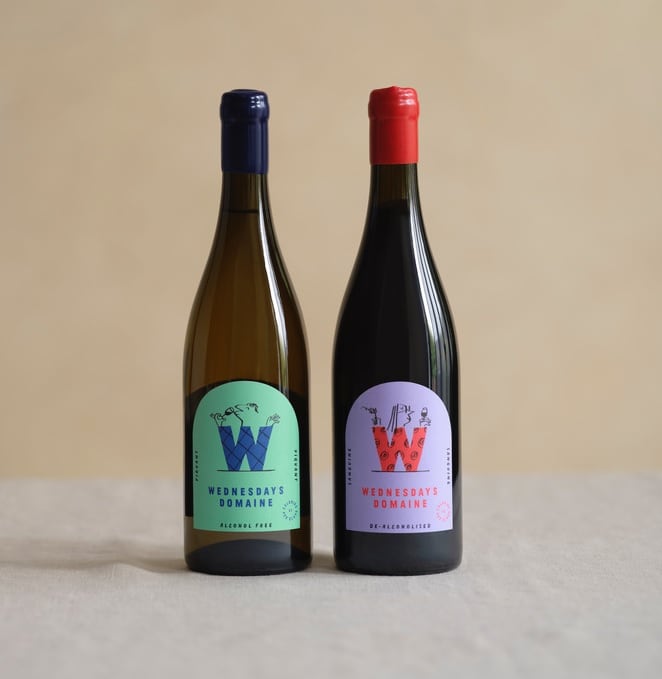
“Alcohol-free wines are a difficult beast to crack and significantly more so than alcohol free beers and spirits,” Luke Hemsley, founder of Wednesday’s Domaine, told us.
“Recognising the complexities involved in creating delicious alcohol-free wines, we’ve focused on the sensory experience of drinking wines.
“When drinking wines, we often think about and remark on their body, complexity, aromas and flavours.
"We’ve considered those elements in the round, looking to create liquids that replicate the experience of drinking wine."
The company has debuted with two wines via the on-trade, off-trade and D2C: with wines available in a host of wine shops, restaurants, and delis across the country.
“We have two still wines, a red (“Sanguine”) and a white (“Piquant”). The way we produce our wines is slightly different from most - instead of using de-alcoholised wine as a finished product, we use it as a base before blending in natural flavours and ingredients.
“Sanguine, our red wine alternative, is made with a Tempranillo base. It has elements of red and dark fruits on the nose, which continue onto the palate before giving way to a drying finish.
“Piquant, our white wine alternative, is made with an Airen Blanco and is characterised by its green fruit and citrus flavours, with a pleasing balance of sweetness and acidity.”
Creating an alcohol-free wine was, says Hemsley, an ‘incredibly difficult and ongoing process’.
“We went through over a hundred iterations of the wines before settling on two options that we were happy to bring to market,” he said.
“We’re constantly gathering feedback and evaluating this alongside our own views of how the wines could evolve and what else we could do next. Working alongside a host of brilliant winemakers, drinks developers and flavourists, I know we’ll get there.
“As a business that exclusively produces alcohol free wine, it really focuses the mind and we’re incredibly excited to continue pushing the envelope.”
And its this kind of innovation that will help spur the alcohol-free wine category forward, says Hemsley, who agrees that convincing consumers to take alcohol-free products seriously has been one of the key challenges to date.
“We think of alcohol-free wine as having two key blockers to growth - awareness and appreciation. A significant number of people still aren’t aware that our category even exists, and a chunk of those who are aware, have had a poor experience previously, so don’t necessarily appreciate the quality of what’s now available in the space.
“This is why, as alcohol free wine producers and brands, we have a collective responsibility to build awareness of the space and bring more people into it. This will happen as we continue to innovate with new products, to build our distribution networks and to carve out unique places in our customers’ hearts and minds.”

